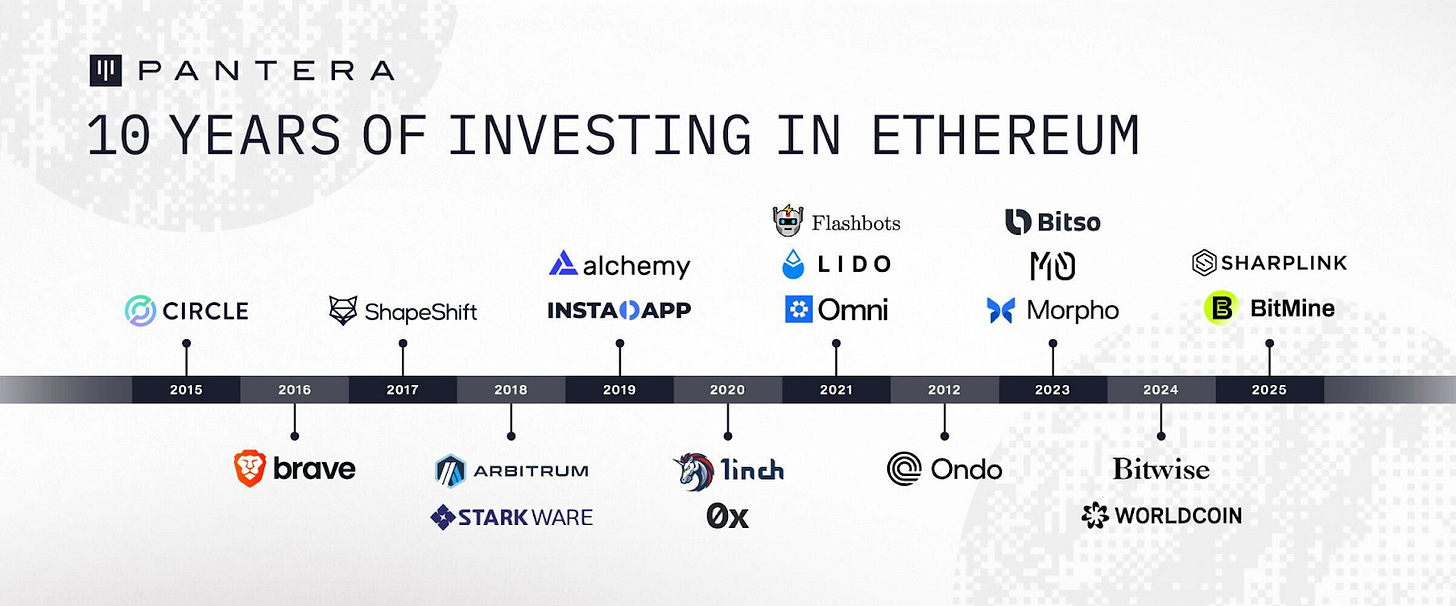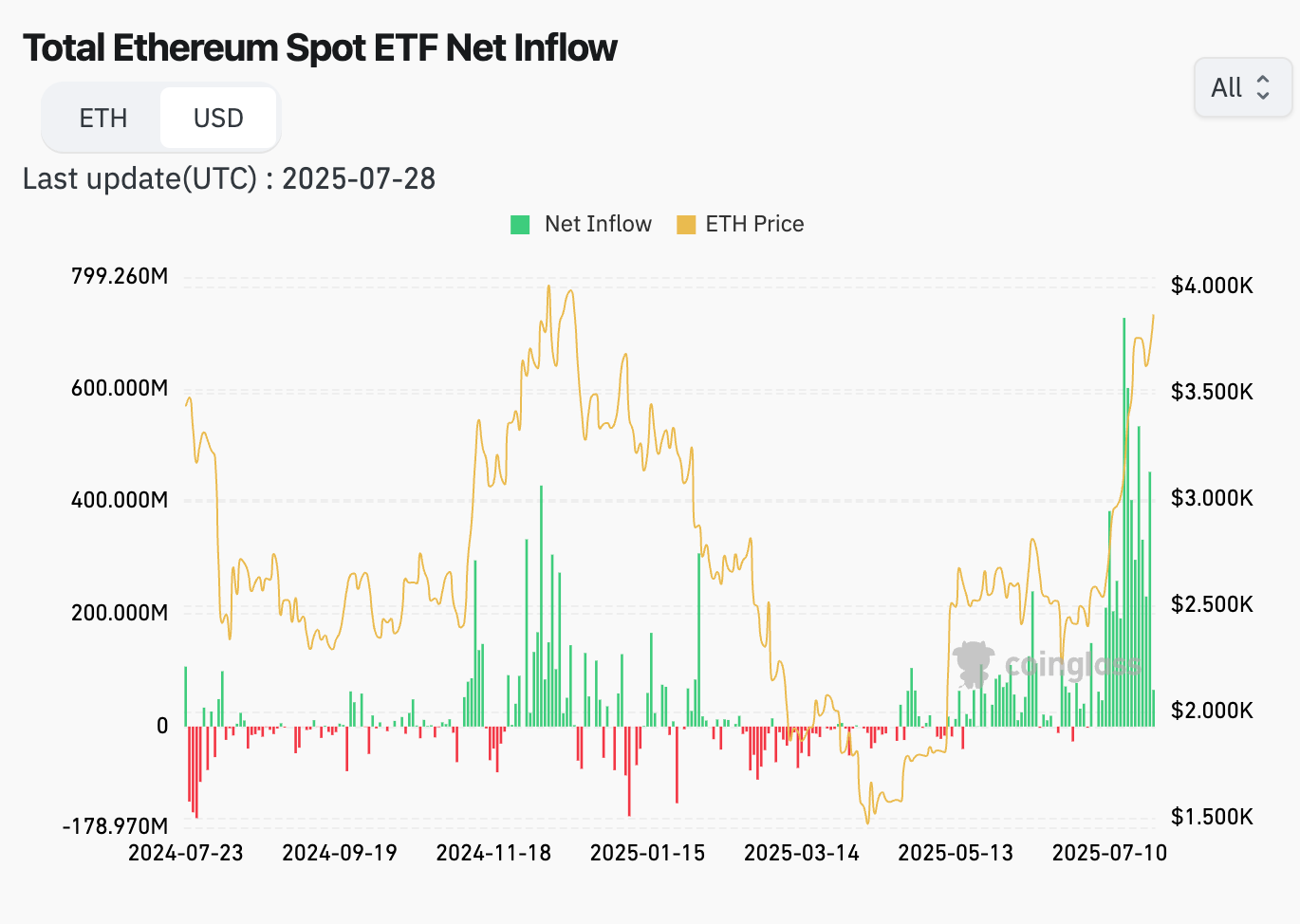Entering its second decade, Ethereum is establishing its position as the foundational layer for stablecoins, DeFi, and tokenized assets.
Author: Paul Veradittakit
Compiled by: Deep Tide TechFlow
Key Takeaways
Entering its second decade, Ethereum is establishing its position as the foundational layer for stablecoins, DeFi, and tokenized assets.
Digital Asset Treasuries (DATs) are reducing token circulation and driving institutional demand for ETH, creating structural price support.
With regulatory clarity and reforms from the Ethereum Foundation, Ethereum is gradually becoming the core infrastructure of on-chain capital markets, enabling long-term growth.
Origins of the Ethereum Vision
Before creating Ethereum, Vitalik Buterin was an early Bitcoin supporter and worked at Bitcoin Magazine. There, he realized Bitcoin's lack of scripting capabilities could not meet the needs of application development. Thus, he proposed a bold vision: to create Ethereum with a universal scripting language designed to run on a decentralized, permissionless network. This idea seemed extremely avant-garde at the time and raised many questions—after all, it was just a young person without a major company background trying to create a completely new technological system.
However, the key to changing the perspective of many early investors was that an increasing number of applications chose to build on Ethereum rather than Bitcoin and its Layer 2 solutions, indicating that Ethereum was more suitable for application development. One of the first "killer applications" that validated this view was Augur—a decentralized prediction market. Augur showcased Ethereum's powerful potential: it could support robust applications based on transparency, automation, and financial logic, while allowing developers to issue tokens, coordinate governance, and raise funds natively, directly giving rise to the ICO (Initial Coin Offering) boom.
A Decade of Ethereum
As Ethereum celebrates its tenth anniversary, it is enjoying a long-awaited moment of glory.
Since its launch in 2015, Ethereum has pioneered programmable smart contracts, gathering a developer community and laying the groundwork for fields such as DeFi, gaming, and NFTs. Over the past decade, this ecosystem has continued to innovate, not only hosting most DeFi protocols but also becoming a core pillar for stablecoins. With the maturation of stablecoin infrastructure, the introduction of the GENIUS Act has brought regulatory clarity while introducing royalty income to Ethereum and enhancing its demand.
Although stablecoins like USDC and USDT exist on multiple chains, Ethereum remains the dominant platform for stablecoin activity, accounting for nearly 50% of the global stablecoin market cap. Ethereum's robust ecosystem continues to drive price growth, propelled by stablecoin adoption and innovative scaling solutions, with strategic investments from Pantera Capital further boosting this growth momentum.
Pantera's Investments in the Ethereum Ecosystem

Over the past decade, Pantera Capital has consistently invested in the Ethereum ecosystem, supporting transformative projects and founders closely tied to Ethereum's growth. Key investments include:
Circle: The driving force behind USDC, with a market cap exceeding $60 billion, promoting widespread adoption of Ethereum in DeFi and payments.
Arbitrum: A leading Layer 2 solution that captured 100% of Ethereum's new transaction growth in 2023, increasing transaction speed by 40 times and reducing costs by 20 times, processing over 1.89 billion transactions, with decentralized exchange trading volume surpassing $54.5 billion, showcasing Ethereum's scalability.
Ondo: Standing out in the multi-billion dollar tokenized asset management market, launching USDY in 2023, connecting real assets like U.S. Treasury bonds with on-chain finance, reinforcing Ethereum's role as core infrastructure.
Morpho: Optimizing the lending experience on Ethereum, with nearly $1 billion in deposits within a year of launch, becoming one of the fastest DeFi protocols to reach this milestone.
Bitwise: Pantera provided early funding for its spot Ethereum ETF, becoming one of the first approved ETFs, attracting institutional capital inflows. By 2025, Bitwise managed assets exceeding $4 billion, leveraging the Ethereum blockchain to drive DeFi and tokenized asset strategies.
BitMine and other companies: Together with companies like Bit Digital, adding over 840,000 ETH to corporate treasuries, highlighting Ethereum's value as a reserve asset.
Through strategic investments, Pantera Capital is driving Ethereum's core position in on-chain finance, scaling solutions, and real asset connections, supporting the ongoing development and innovation of its ecosystem.
Institutional Demand, Digital Asset Treasuries, and Changes in Ethereum's Supply Landscape
Ethereum surged 53% in July, and this strong rise is not driven by speculation but by structural factors: institutional investments in ETFs and Digital Asset Treasuries (DATs), the transformation of the Ethereum Foundation, and recent regulatory clarity.
Institutional interest in crypto assets is focused on the ETF and DAT sectors. Last week, U.S. spot ETH ETFs attracted $1.8 billion in inflows, while DATs have begun to accumulate ETH on a large scale. SharpLink (SBET) increased its reserves to 361,000 ETH, and BitMine surpassed $2 billion in Ethereum holdings in just 16 days. As mentioned by Tom Lee of MicroStrategy and Cosmo Jiang of Pantera in a conference call, these asset management companies have built-in advantages: low-cost capital, equity premiums, staking yields, merger arbitrage, and operational income, allowing each new stock issuance to increase their per-share ETH holdings. This unique structure continuously reduces Ethereum's circulation, providing price support beyond simple demand.

Source: https://www.coinglass.com/eth-etf
DATs are no longer a novelty in the native cryptocurrency space but are becoming the entry point for institutional investors to engage with cryptocurrencies and Ethereum, allowing them to gain exposure before purchasing spot or engaging in on-chain trading. As I mentioned in my previous blog “Blockchain Going Public: The Convergence of Public Markets and Digital Assets”, these tools concentrate significant purchasing power, often absorbing more ETH than the issuance, driving scarcity and prompting broader capital rotation into other altcoins.
Regulatory Clarity and Strategic Shifts at the Ethereum Foundation
The improvement in the regulatory environment is transforming past obstacles into tailwinds. In July, the GENIUS Act granted federally chartered status to regulated payment stablecoins. Stablecoins have quietly become the killer application of cryptocurrencies, with a circulation exceeding $250 billion, of which Ethereum settled about half of the tokenized dollar transfers globally.
Meanwhile, the new leadership and rapid development of the Ethereum Foundation (EF) are driving rapid iterations of the chain. This transformation includes leadership restructuring, protocol team adjustments, strict treasury policies, and an accelerated technical roadmap to address community criticisms regarding efficiency, transparency, and competitiveness. By focusing on Layer 1 scaling, Blobspace (data storage space), user experience (UX) optimization, and DeFi integration, the aim is to solidify Ethereum's dominant position in institutional adoption (such as Robinhood's stock tokens on Arbitrum) and blockchain competition (like Solana). Despite facing challenges such as talent retention and community expectation management, EF's strategic transformation lays the groundwork for Ethereum to seize opportunities in the migration of capital markets on-chain, exemplified by the emergence of innovative cases like Robinhood Chain and Pantera ecosystem investments.
Final Thoughts
Stablecoins have finally locked in a reliable trajectory, bolstered by regulatory clarity from legislation like the GENIUS Act, which has boosted their demand. Digital Asset Treasuries are the engine behind this demand. They absorb market circulation, drive up prices, and provide institutions with a one-stop solution for holding crypto assets. In today's market, which values structural yields more, tokens that exhibit deflationary pressure and are linked to real cash flows will become ideal underlying assets for DATs. This trend will further drive Ethereum's price upward, while demand for the Ethereum blockchain will surge accordingly.
We are at a critical moment of significant infrastructure transformation, which requires not a magic bullet but a series of solutions capable of addressing numerous challenging issues. At Pantera Capital, we are committed to investing in solutions that empower the next phase of on-chain capital markets, simplify financial infrastructure, and expand the horizons of blockchain innovation. Ethereum is at the center of this transformation, serving as the core pillar for stablecoins, a favored platform for institutions, and a catalyst for the continuous evolution of the digital asset economy, leading the industry into a new future.
免责声明:本文章仅代表作者个人观点,不代表本平台的立场和观点。本文章仅供信息分享,不构成对任何人的任何投资建议。用户与作者之间的任何争议,与本平台无关。如网页中刊载的文章或图片涉及侵权,请提供相关的权利证明和身份证明发送邮件到support@aicoin.com,本平台相关工作人员将会进行核查。




